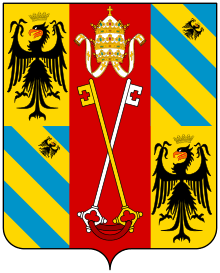Duchy of Urbino
| (County) Duchy of Urbino | ||||||||||
| Ducato (Contea) di Urbino | ||||||||||
| State of the Holy Roman Empire | ||||||||||
| ||||||||||
 Coat of arms
| ||||||||||
 The Duchy of Urbino in the 17th Century | ||||||||||
| Capital | Urbino (1443 - 1523) Pesaro (1523 - 1631) | |||||||||
| Government | Feudal monarchy | |||||||||
| Historical era | Middle Ages Renaissance Early modern | |||||||||
| • | County created by Emp. Frederick II |
1213 | ||||||||
| • | Raised to duchy by Pope Eugene IV |
1443 | ||||||||
| • | Annexed to the Papal States |
1625 | ||||||||
| ||||||||||
| Today part of | | |||||||||
The Duchy of Urbino was a sovereign state in central-northern Italy.
The first lords of Urbino were the House of Montefeltro, who obtained the title of counts from Emperor Frederick II in 1213. The first Duke was Oddantonio, who received the title from Pope Eugene IV in 1443. The duchy's territories occupied approximately the northern part of the modern region of Marche: they were bordered by the Adriatic Sea in the east, the Republic of Florence in the west and by the Papal States southwards.
In 1523 the capital was moved to Pesaro. After the short rule by Cesare Borgia in 1502–08, the dukedom went to the della Rovere papal family, who held it until 1625, when Pope Urban VIII annexed it to the Papal States as Legazione del Ducato di Urbino (later Legazione di Urbino).
| Name | Birth | Reign | Death | Consort |
|---|---|---|---|---|
| Federico II da Montefeltro[1] | 1364–1370? | 1370? | Teodora Gonzaga | |
| Antonio II da Montefeltro[1] | 1348 | 1363–1404 | 29 April 1404 | Agnesina dei Prefetti di Vico |
| Guidantonio da Montefeltro[1] | 1377 | 1403–1443 | February 1443 | Ringarda Malatesta; Caterina Colonna |
| Oddantonio da Montefeltro[1] created Duke | 1428 | 1443–1444 | 22 July 1444 | Isotta d'Este |
| Federico III da Montefeltro[1][2] | 7 June 1422 | 1444–1482 | 10 September 1482 | Gentile Brancaleoni; Battista Sforza |
| Guidobaldo da Montefeltro[1][2] | 17 January 1472 | 1482–1502 | 10 April 1508 | Elisabetta Gonzaga |
| Cesare Borgia[3] | 1502–1503 | Charlotte of Albret, Lady of Châlus | ||
| Guidobaldo da Montefeltro[1][2] | 17 January 1472 | 1503–1508 | 10 April 1508 | Elisabetta Gonzaga |
| Francesco Maria I della Rovere[1][2][4][5] | 22 March 1490 | 1508–1516 | 20 October 1538 | Eleonora Gonzaga |
| Lorenzo II de' Medici[6] | 12 September 1492 | 1516–1519 | 4 May 1519 | Madeleine de la Tour d'Auvergne |
| Francesco Maria I della Rovere[1][2][4][5] | 22 March 1490 | 1521–1538 | 20 October 1538 | Eleonora Gonzaga |
| Guidobaldo II della Rovere[1][2][4][5] | 2 April 1514 | 1538–1574 | 28 September 1574 | Giulia da Varano; Vittoria Farnese |
| Francesco Maria II della Rovere[1][2][4][5] | 10 February 1549 | 1574–1621 | 23 April 1631 | Lucrezia d'Este; Livia della Rovere |
| Federico Ubaldo della Rovere[1][2][5] | 16 May 1605 | 1621–1623 | 28 June 1623 | Claudia de' Medici |
| Francesco Maria II della Rovere[1][2][5] | 10 February 1549 | 1623–1625 | 23 April 1631 | Livia della Rovere |
See also
Notes
- 1 2 3 4 5 6 7 8 9 10 11 12 13 Also count or duke of Montefeltro, count of Castel Durante, lord of Cagli, Gubbio, Cantiano, Frontone and Sassocorvaro.
- 1 2 3 4 5 6 7 8 9 Also count of Mercatello, lord of Pergola and Fossombrone.
- ↑ Also duke of Valentinois and Romagna, prince of Andria and Venafro, count of Dyois, lord of Forlì, Imola, Rimini, Piombino and Camerino.
- 1 2 3 4 Also duke of Sora and Arce.
- 1 2 3 4 5 6 Also lord of Senigallia.
- ↑ Also ruler of Florence.
References
- James Dennistoun (1851). Memoirs of the Dukes of Urbino, Illustrating the Arms, Arts, and Litterature of Italy, from 1440 to 1630: In Three Volumes. Longman, Brown, Green and Longmans. Volume One, Volume Two, Volume Three
- History of the popes; their church and state (Volume III) by Leopold von Ranke (Wellesley College Library, 2009)
- Franceschini, G. (1970), I Montefeltro . Milan.
- Ugolini, Filippo, (1859). Storia dei conti e duchi d'Urbino. Florence.
- Ugolini, Filippo, Storia dei conti e duchi d'Urbino - volume 2.
Coordinates: 43°43′N 12°38′E / 43.717°N 12.633°E